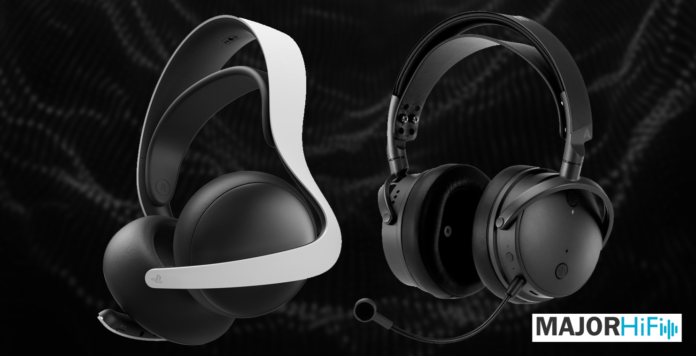The Audeze Maxwell is among the best gaming headphones on the market. After its release, Audeze was bought by Sony Interactive Entertainment. The Pulse Elite is the first headphone to be released using Audeze’s technology, but is it better than Audeze’s previous effort?
What You Get
| PlayStation Pulse Elite | Maxwell |
|
|
Look & Feel
The Pulse Elite takes on the aesthetic of the PS5, while the Maxwell has a chunkier, heavy-duty build. With the Maxwell, you get a sturdier design, with high-grade materials that appear more durable compared to the Elite. Both headphones give off a cool look, and I particularly like how they implement their boom mics. Wearing the Pulse Elite gives off a lighter feel compared to the Maxwell, but I prefer the isolation Audeze’s headphones give you. The Elite is comfortable, but sometimes the fit can feel a bit loose. I have one bit of gripe with the Maxwell though, and it’s the headband. The three-hole design is not one that I favor, especially compared to the Elite’s headband, which adjusts automatically.
Design
Sony’s Pulse Elite headphones adapt Audeze’s planar design principle, but information on the driver’s exact size is not made specific. However, we do know that the Maxwell has a 90mm driver, which is pretty sizable. I’ve heard some complaints about the Maxwell’s loudness quality, but after some firmware updates it’s gotten better. This is not a problem for the headphones when used over PlayStation, as they both output the same amount of volume. EQ controls can also be used through the PlayStation, but Audeze also has its own app called Audeze HQ.
Microphone Quality
This is one of the few areas where one headphone is outright better than the other and it would be hard to say otherwise. The Pulse Elite’s mic quality is very disappointing compared to the Maxwell. When I was testing the Pulse Elite for my review, I noted that my voice came across as boxy when chatting with my friends over Discord on the PlayStation. The Maxwell doesn’t have this issue, and while the voice quality still isn’t perfect, it’s way more clear than the Elite.
Bluetooth & Battery Life
There is a clear winner for battery life and that’s the Maxwell. It offers 80 hours of playtime compared to the Pulse Elite’s 30 hours. Both are appropriate for their price points though, and I never had a problem with the charge time of either of them. In terms of their wireless connection, both headphones are on a similar level. They both offer dongles that give you low-latency wireless connections that you can use with Bluetooth simultaneously.
Soundstage
I thought it would be fitting to directly compare the PlayStation version of the Maxwell to the Pulse Elite for obvious reasons and to see how they handle Tempest 3D audio with the PS5. Testing was also done on PC, but only the XBOX version allows you to use Dolby Atmos. Listening to the Maxwell in Dolby Atmos wields better results in terms of spatial performance. Still, since we’re comparing it with the Pulse Elite, it’s fairer to judge the soundstage based on how it functions with the PlayStation.
Even with these parameters set, the Maxwell still impresses me more with its soundstage than the Pulse Elite. While Sony’s headphone showcases better pure stereo dynamics than most of its other efforts, the Maxwell still outclasses it. No matter how it acts in 3D, you can still tell which headphone has the better soundstage based on stereo accuracy and depth. The Maxwell shows a better identity with specific effects and music through the left and right channels, enwrapping your head in an immersive sonic environment before you even activate spatial audio. The Pulse Elite should get some credit though for exercising breathability in the soundstage. It allows for sounds to also feel more localized in a specific place, but the Maxwell is more elegant with its imaging overall.
Listening to sounds whirl around you like wind or flames over the Maxwell has more movement behind it than the Pulse Elite. However, switching to 3D makes them more similar in terms of spaciousness. The Maxwell still retains its superior accuracy and width over the Pulse Elite, but the Pulse Elite has more of a hovering effect. In this case, the 3D audio might be more fun with the Pulse Elite as sounds are propelled into a more forward headspace. The Maxwell still has the better height and depth though, featuring a better scale to singular sound elements than the Pulse Elite.
Low End
I respect the level of balance that the Pulse Elite exhibits with its lows like the bass has restraint to it. This might not be what you’re looking for in a pair of gaming headphones, but it can make a difference in terms of clearer sound fidelity. Thankfully, you can boost the bass to your liking with the PlayStation’s EQ, which adds more presence and texture to the bass frequencies. With the Maxwell, the bass features greater impact and rumble throughout its sound signature. It slams down with a quick, thunderous vibration of tone. Surprisingly, the bass never gets out of control with this response. The Maxwell presents a sub-bass that makes all the difference, giving a pointed buzz to bass-heavy sound effects and instruments.
Mids
Both headphones exhibit a V-shaped sound profile. This is common for a lot of gaming headphones, but that doesn’t stop the Maxwell and Pulse Elite from showcasing better properties. This is thanks to their planar drivers, which make the mids come across a bit more transparently, but the Maxwell ends up with better balance than the Elite. You can hear a dip in energy when dialogue occurs over both headphones, but neither push sounds toward the background. I think the Pulse Elite just comes across as a hollower timbre overall compared to the Maxwell. When it’s time for both headphones to show excitement in the upper-mids, the Maxwell feels a lot more detailed. The Pulse Elite has some good energy to it here, but the resolution isn’t as clear.
Highs
While the Maxwell outdoes a lot of what the Pulse Elite can do in terms of fidelity, the highs appear surprisingly more lifelike. The Maxwell has solid crispness in its treble, but the timbre is more veiled than the Pulse Elite. It appears less believable than the Pulse Elite, which is more expressive in comparison. There’s more brightness to it, but the response rings out more and takes on a clearer shape than the Maxwell. It can be a bit peaky and forward, but I prefer its coloration over the colder high frequencies that the Maxwell presents.
Summary
Sony’s future gaming headsets have the opportunity to take more of what the Maxwell does right, but for now, both headphones still have their pros and cons. The Maxwell sounds like a great headphone in general, while it’s hard to find much use for the Pulse Elite outside of gaming on your PS5. The Elite does surprise me though, with its expressive highs, easy adjustability, and generous price point.
The Audeze Maxwell is available at Audio46, and the Sony PlayStation Pulse Elite is available from Sony here.
MAJORHIFI may receive commissions from retail offers.








